Fish tank keepers often come across a common question, i.e., “whether or not aquarium plants can grow in sand?”
Well, they can grow. But not every aquarium plant can grow in sand. That’s because certain plants do not get the required nutrients from the sand that they need for proper growth.
On the other hand, the aquarium plants that can survive in the sand take nutrients straight from the tank water. They do this because plain sand does not hold any nutritional value that’s needed.
But if the aquatic plants that you have added in the sand are not good at sucking nutrients from the tap water, you can add root tabs. They will help the plant grow in a better way.
Since aquarium plants can grow in the sand, you can find multiple options. But our favorite one is the Amazon Swords. It has big and beautiful leaves that make the aquarium look better than before.
Besides Amazon Swords, this post has other excellent aquatic plant options as well. You can go through the details to know their temperature, pH, and lighting needs. Also, in the end, we have discussed how you can perfectly grow an aquarium plant in the sand.
Keep reading to get into details!
Table of Contents
List of Easy Aquarium Plants to Grow in Sand
Among the available options, the below-mentioned plants are the best. All of them can be easily managed and have a standard requirement.
So, no matter whether you have a small aquarium or a big one, you can add these plants to make your tank beautiful. In addition, plants also offer a better place for fish to hide.
Also, if you are looking for freshwater plants for beginners or best houseplant for aquaponics fish tanks, then don’t out on these guides.
- Amazon Swords
- Java Fern
- Java Moss
- Anubias Barteri
- Anacharis
- Ludwigia Repens
- Madagascar Lace
- Camboba
- Rotala Indica
- Dwarf Hairgrass
- Myrio Filigree
- Lemon Bacopa
#1 Amazon Swords
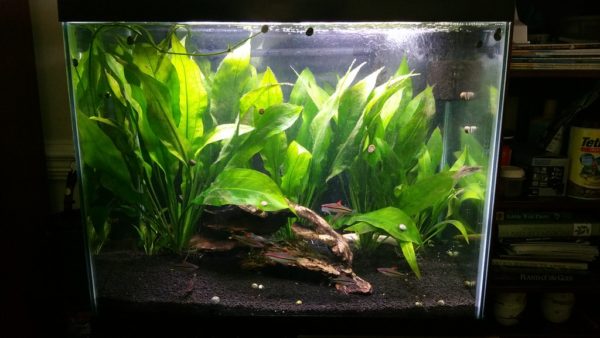
An excellent aquatic plant that can survive in the sand is the Amazon Sword. And if you are a beginner, this is the right plant to start with. This beautiful plant has long leaves, which grow and become even more attractive under the right circumstances.
For planting Amazing Sword, you must nicely bury the roots in the substrate. Make sure its crown is above the sand.
Since Amazon Swords is a heavy root feeder, it needs root tabs. So, don’t forget to add it; otherwise, the plant might look unhealthy and dull. Its tendency to adapt to a wide range of living conditions makes it popular among tank keepers.
| Maintenance | Medium |
| Temperature | 72-82F |
| pH | 6.5 to 7.5 |
| Size | 20 inches |
| Fertilizer required | Root tabs + iron rich |
| Lighting | Moderate |
For its proper growth, Co2 is needed. Without it, the plant will grow slowly. Also, depending on the type of aquarium, you must pick the right-sized Amazon Sword. If you have a smaller tank, go for the dwarf version. Otherwise, you can get a normal size plant.
#2 Java Fern
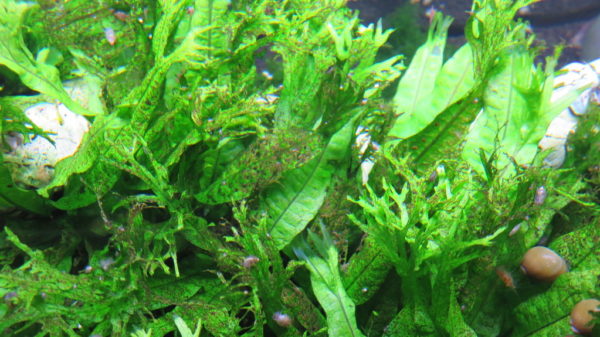
Next on this list is the Java Fern that is considered to be the happiest aquatic plant. You can grow it in your fish tank by burying its roots deep into the tank. Make sure the rhizome is not in the sand.
After placing it in the tank, you don’t have to add any fertilizer or Co2. While these things can help the plant grow faster, Java Fern can nicely survive without them.
This plant propagates on itself, and it requires patience. So, let the plant sit in the tank and see the baby java fern leaves grow massive without disturbing them.
| Maintenance | Low |
| Temperature | 68-82F |
| pH | 6 to 7.5 |
| Size | 13 inches |
| Fertilizer required | No |
| Lighting | Low to moderate |
Java Fern is great for both experienced and novice tank keepers. Instead of burying the roots, you can also attach them to a piece of wood or rock.
#3 Java Moss
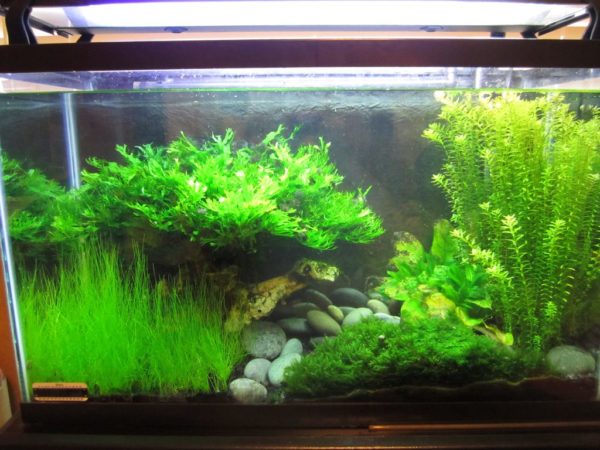
Compared to all the aquarium plants that can survive in the sand, Java Moss is the toughest plant. This feature makes it one of the first choices by beginners and novice tank keepers.
This lush green plant does not require much care as it can comfortably grow in various living conditions. Another interesting thing about this aquatic plant is its rhizoids. This thing helps the plant get nutrients from any surface it’s kept on.
While it does not have many requirements, it likes living in an excellent current zone. So, if you want to keep the plant happier, keep it in a tank that has better water movement.
| Maintenance | Low |
| Temperature | 68-82F |
| pH | 6 to 7.5 |
| Size | 8 inches |
| Fertilizer required | No |
| Lighting | Low to moderate |
Java Moss grows perfectly fine without adding any fertilization or Co2. But you can give it occasional trim.
#4 Anubias Barteri
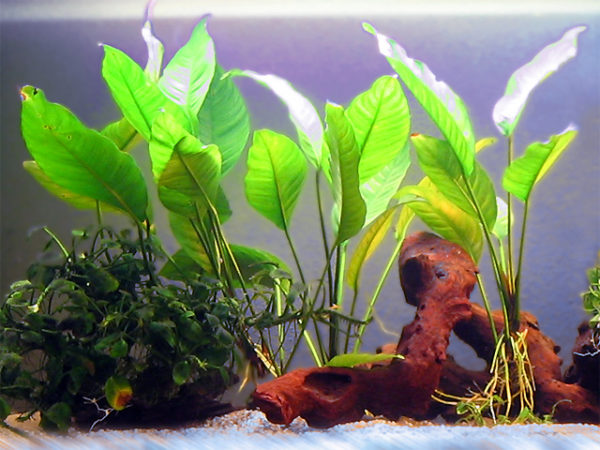
Just like Java Moss, Anubias Barteri is also a happy plant. For its healthy growth, you can attach it to rocks and then anchor it in a substrate. But while burying it in the sand, don’t cover the rhizomes.
An important thing to note here is that it grows slower. Also, it does not need fertilization or Co2. If you want, you can add these additional substances, but survival is possible without them.
Anubias Barteri is ideal for both beginners and expert tank keepers as it can be easily maintained. Also, it looks stunning, further enhancing the beauty of the aquarium.
| Maintenance | Low |
| Temperature | 72-82F |
| pH | 6.5 to 7.5 |
| Size | 12 inches |
| Fertilizer required | No |
| Lighting | Low to moderate |
It will grow nicely even in low light.
#5 Anacharis
Anacharis is also called waterweed because it grows fast. This beautiful green aquarium plant doesn’t care whether you have kept it in sand or soil because its roots can take nutrients even from the harshest living conditions.
If you want to plant Anacharis, trim it frequently because its fast growth speed can make it take over the fish tank in no time. You can grab a pair of scissors and trim off the extra bits.
It does not have any additional requirements to grow, but it needs proper lighting. In a dull living condition, it will die.
| Maintenance | Medium |
| Temperature | 59-82F |
| pH | 6.5 to 7.5 |
| Size | 24 inches |
| Fertilizer required | If in tropical |
| Lighting | Moderate |
Anacharis does not need root tabs. Also, when you trim the plant, properly dispose of it because if it gets into the sand, it will continue to grow.
#6 Ludwigia Repens
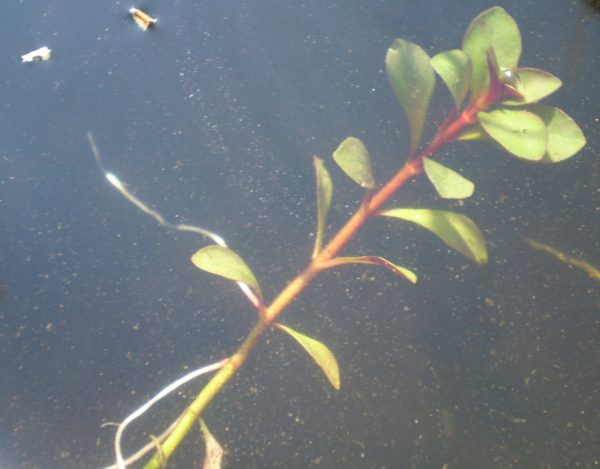
If you want to add colors to your fish tank, try growing Ludwigia Repens. It’s a beautiful plant that ranges from deep green to deep red. You can grow it in your tank in the sand substrate.
Even if the plant gets taller than the tank, it will grow. But if you don’t want that, frequently trim it to make it more fluffy and greenish.
Ludwigia Repens requires a proper level of lighting. If it does not get the light, its leaves will lose beautiful colors, making it look dull. Ludwigia Repens can be easily propagated either by using flowers, seeds, or rooting stems.
| Maintenance | Medium |
| Temperature | 72-82F |
| pH | 6.5 to 7.5 |
| Size | 18 inches |
| Fertilizer required | No |
| Lighting | Moderate to high |
It is suggested to provide this plant with 2 watts of light per gallon. But if you want the leaves to turn red, use 4 watts of light per gallon.
#7 Madagascar Lace
Madagascar Lace is a beautiful aquatic plant that can be grown in sand. Its lush green leaves can make your tank beautiful. Also, it can offer enough places to fish where they can relax and hide.
But this stunning plant is unfortunately hard to grow. You can, of course, grow it on the sand. However, it requires a specific kind of sand, like coarse sand, for proper growth. In addition, it needs fertilizers.
Use a good-quality water column fertilizer that can help Madagascar Lace grow happily and perfectly. If you offer it everything that it needs, you will reward it with a stunning-looking plant.
| Maintenance | High |
| Temperature | 62-72F |
| pH | 6 to 7 |
| Size | 25 inches |
| Fertilizer required | Yes, water column that includes iron and trace elements |
| Lighting | High |
If you are a beginner, you might want to skip this aquatic plant because you will get overwhelmed meeting its requirements.
#8 Camboba
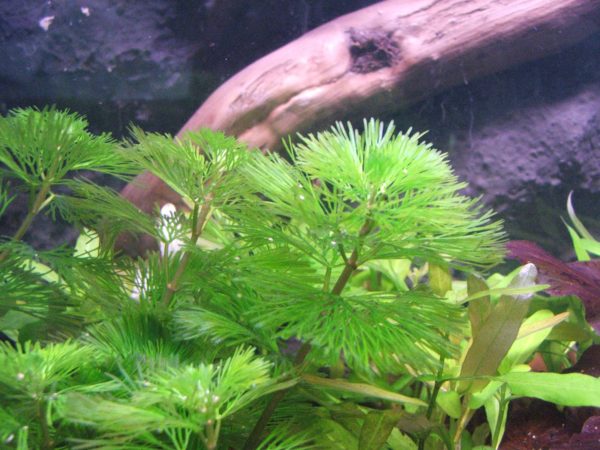
Just as Madagascar Lace looks unique, the Camboba also looks excellent. And the best thing is that it does not require much maintenance. Besides green, it also comes in red, which looks even more stunning.
It’s one of the most adaptable aquatic plants that you can find to grow in sand. Camboba is also a flowering plant. So, you need to give it proper attention and care when it’s budding; otherwise, the flower might die.
If you don’t want that to happen, increase the Co2 level and fertilizer in the tank. However, you can skip the Co2 and fertilizer part if you like Camboba without flowers.
| Maintenance | Low |
| Temperature | 72-82F |
| pH | 6.5 to 7.5 |
| Size | 20 inches |
| Fertilizer required | No |
| Lighting | Moderate |
While Camboba needs moderate lighting conditions, its lighting requirements will increase if it’s flowering.
#9 Rotala Indica
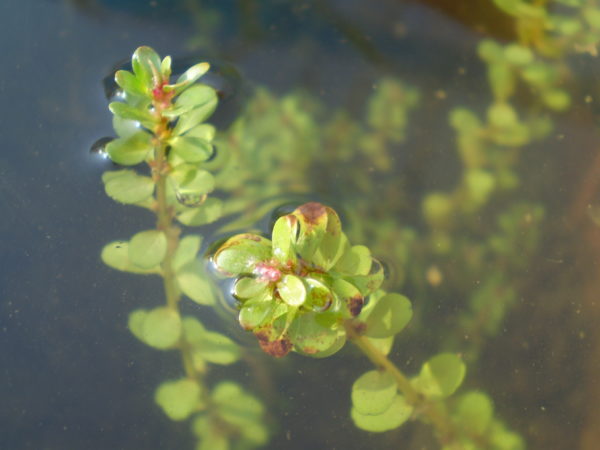
Another easy-to-grow plant that you can pick for your aquarium is Rotala Indica. It looks a little different, but that’s what makes it beautiful. It will give an attractive look to your tank, making it stand out.
The best thing about Rotala Indica is that it does not need extra fertilizer or Co2. But you can add those things if you want this plant to grow quicker and better. Doing a few extra things can also enhance its beauty.
The only thing that you need to consider while housing Rotala Indica is its maintenance. If its leaves are growing too big, you can trim them. This way, your plant will not look wild.
| Maintenance | Medium |
| Temperature | 72-82F |
| pH | 6.5 to 7.5 |
| Size | 14 inches |
| Fertilizer required | No |
| Lighting | Moderate to high |
One interesting thing about Rotala Indica is that it can grow new stems from the cut that you have made. This thing helps it to get bushier and enhances the beauty of the fish tank.
#10 Dwarf Hairgrass
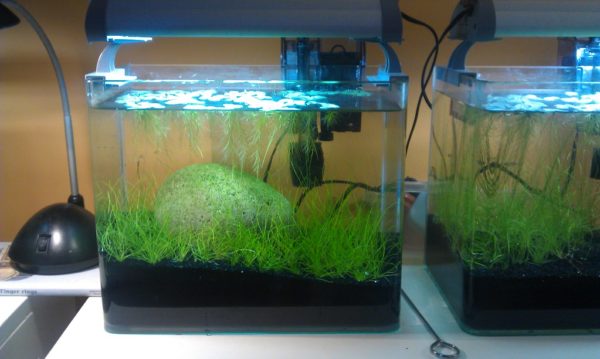
If you want to add green lush-like grass to your tank, try growing Dwarf Hairgrass. This unique plant does not have overwhelming maintenance needs. You can see it as a stunning carpet plant that offers a real-like feel to the aquarium.
What makes Dwarf Hairgrass so unique is its tendency to grow in the tank water even without being planted in the sand. Generally, it does not require any added fertilizer. But if you want it to grow like full carpet grass, you can add Co2.
Besides this, adding a better lighting setup can also help grow this plant in the best way.
| Maintenance | Medium |
| Temperature | 70-83F |
| pH | 6.5 to 7.5 |
| Size | 4 inches |
| Fertilizer required | No |
| Lighting | Moderate |
To make your tank look better, remember to spread out Dwarf Hairgrass into small clumps. This way, the grass will spread in the entire tank, making it look stunning.
#11 Myrio Filigree
Another entry on this list is the Myrio Filigree. This unique aquatic plant has a striking stem structure. It looks great in the aquarium and grows nicely on the sand. In addition, it has excellent growth speed. Well, that’s all the reason why you must get it.
Myrio Filigree is perfect for both beginners and experienced aquarium keepers. But one thing that needs to be considered while growing this plant is the Co2 level. Sometimes, this plant can die if the Co2 cartridge runs out.
Besides Co2, it also needs a water column. If you have properly offered it everything it needs, you can enjoy seeing a beautiful Myrio Filigree in your aquarium.
| Maintenance | Medium |
| Temperature | 70-82F |
| pH | 6 to 7.5 |
| Size | 2 inches |
| Fertilizer required | Yes, the water column |
| Lighting | Moderate |
It definitely requires some extra work, but the results are worth it.
#12 Lemon Bacopa
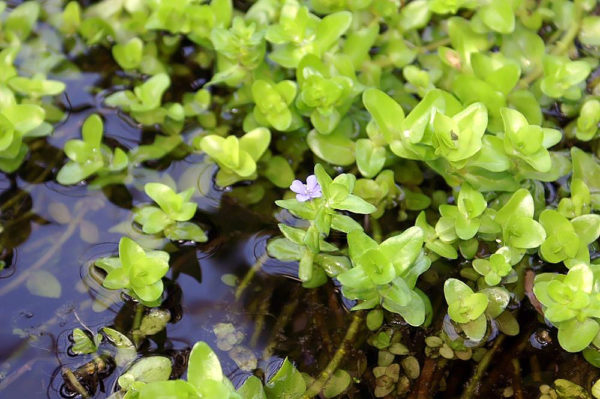
Lastly, you can consider adding Lemon Bacopa. It’s also known as water hyssop, and it’s one of the best choices for growing in the sand as it’s tough. With minimum requirements and maintenance, it can grow into a beauty.
Ideally, Lemon Bacopa does not require any fertilizer. But if you want, you can add a certain kind of fertilizer to it to make its leaves grow bigger and greener.
While planting it, avoid housing any other plant that might flow on the tank water surface and stop the light from reaching it.
| Maintenance | Low |
| Temperature | 68-82F |
| pH | 6 to 7.5 |
| Size | 2 inches |
| Fertilizer required | No (but you can add root tabs and water column) |
| Lighting | Moderate |
Lemon Bacopa can give your fish tank a natural vibe. So, you can add it.
How to Grow Aquarium Plants in Sand
Growing aquatic plants in the sand is possible as several plants can survive in the sand substrate.
While making a plant survive in the sand is tricky, the effort is worth it. Aquatic plants in a fish tank offer a better survival surface for bacteria colonization. Also, sand in the bottom helps plants to create a jungle-like feeling.
But how will you make your plant survive the tank condition? How will you make it grow happily? And how will you keep it alive? You will find the answers to these questions in the below section.
Make the Sand Safe For Fish
Before pouring the sand into the tank, clean it using water. You might lose some sand in the cleaning process, but this will protect the fish and prevent water cloudiness. Cleaning of sand helps in removing the dust.
Place the Sand
While pouring the sand into the fish tank, try creating a two to three-inch-thick glass bottom with it. This step is necessary because plants need extra space to expand their roots.
Fill the Tank
After filling the tank with sand, you can then add water. Fill the aquarium properly because high the pouring speed or pressure can stir the sand. You can use any method or trick to protect the sand from moving.
Fertilize the Sand for Plant
Certain plants do not need any fertilizer to survive and grow. But it’s still advised to mix the sand with fertilizers. Doing this will keep the plants healthy and green.
You can choose liquid fertilizers or root tabs depending on the plant you are growing in the tank.
Anchor the Plant
The last step is anchoring the plant. If you skip this step, your plant might start flowing, which is the last thing you want to see. A simple way to anchor the plant is using a plastic cap or stone.
Conclusion
Growing aquatic plants in the sand is tricky, but you can do it with a bit of help and proper knowledge. When choosing the plant for the aquarium, consider the size of the tank as well. If it’s small, you should pick aquatic plants that do not grow too big. Otherwise, you can choose any plant.
Also, it’s essential to follow each step required for growing aquarium plants carefully. This way, your plants won’t die, and you will have a beautiful aquarium.
No related posts.
